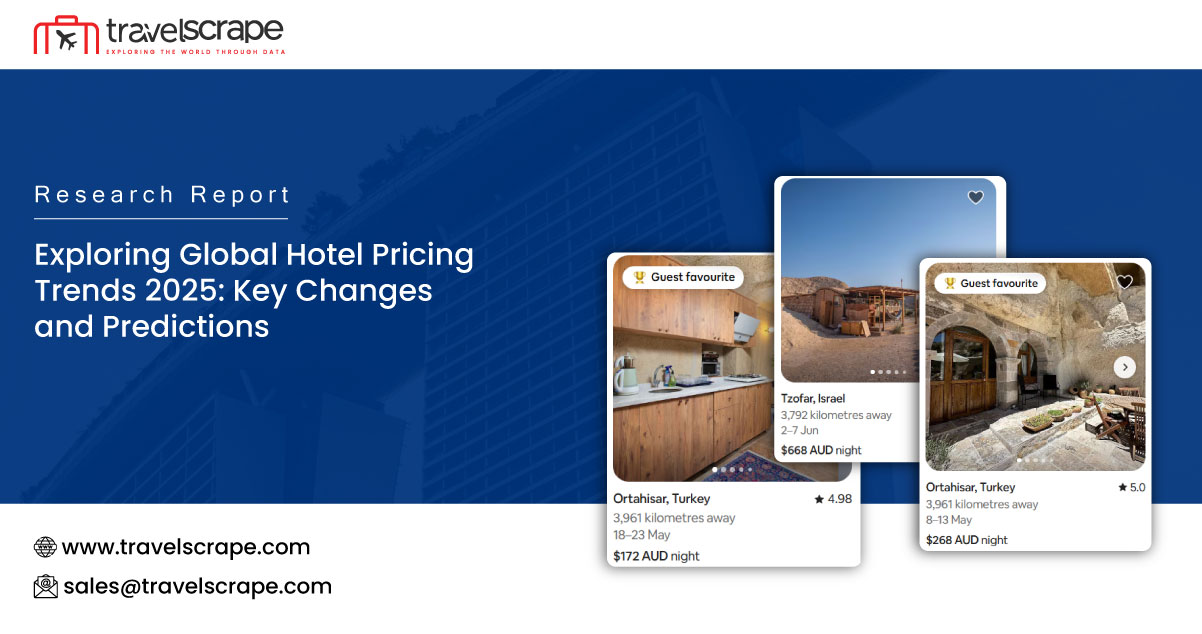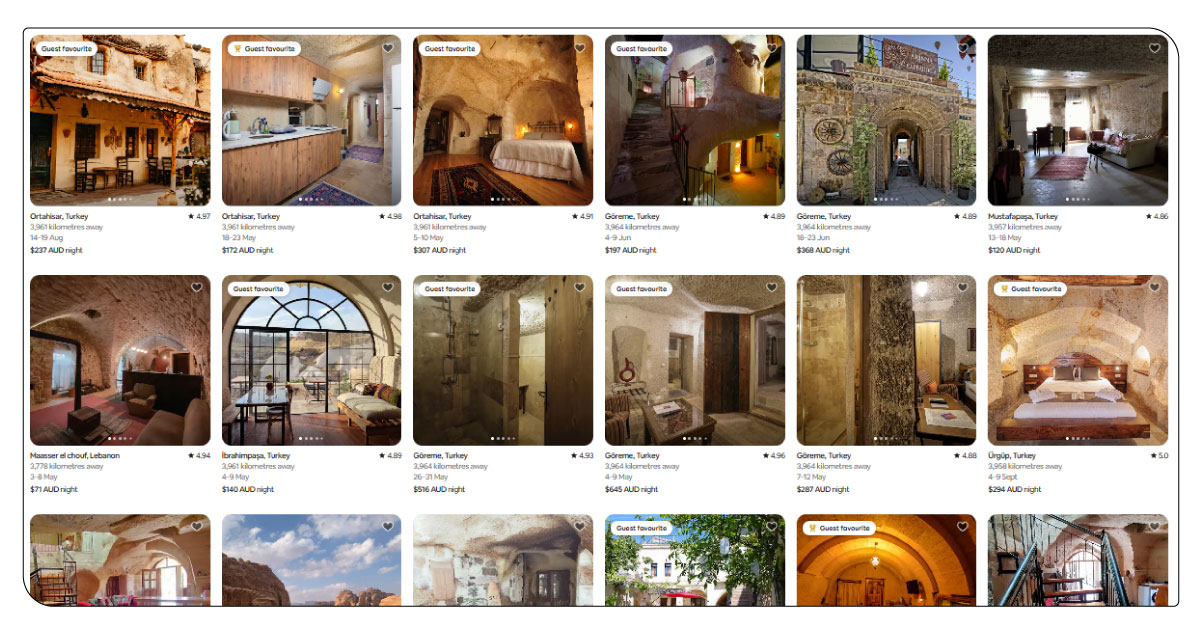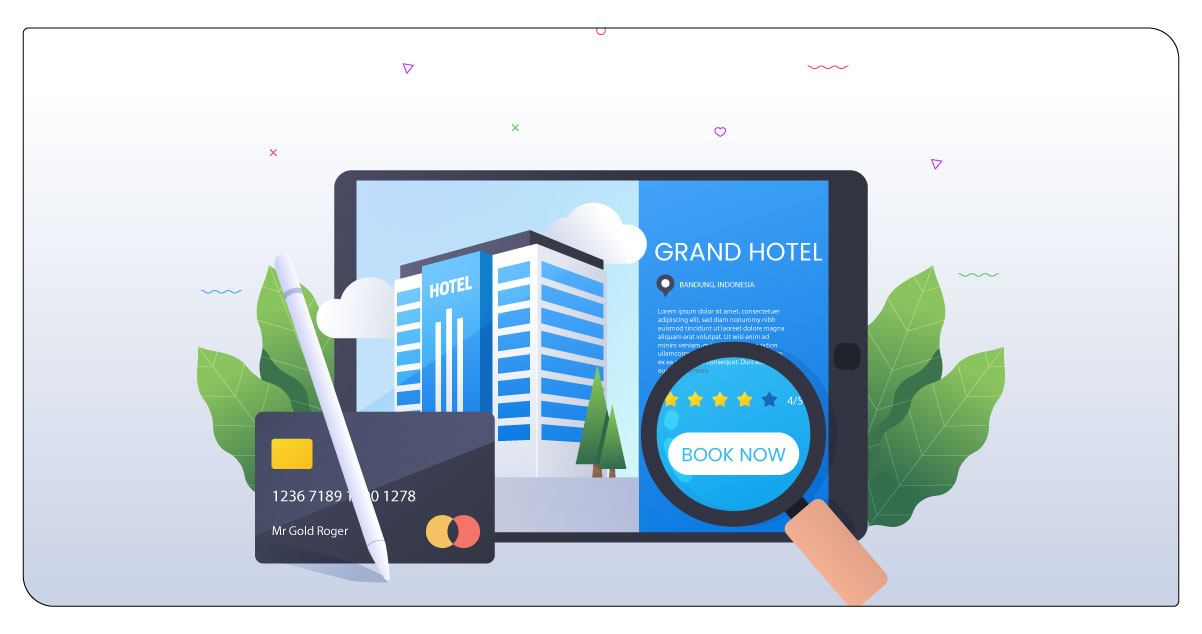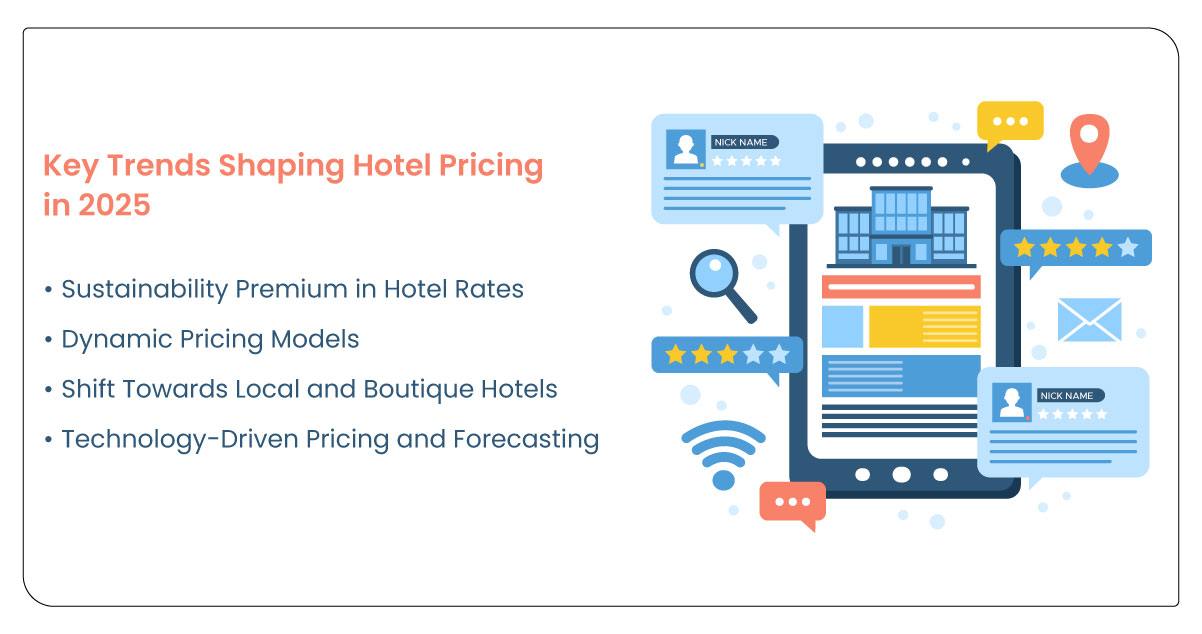Exploring Global Hotel Pricing Trends 2025: Key Changes and Predictions

Introduction
The Global Hotel Pricing Trends 2025 report offers a detailed analysis of the factors driving changes in hotel rates and their impact on the hotel industry and travel patterns worldwide. Based on the analysis of over 50,000 hotel listings, this report utilizes cutting-edge Web Scraping For Travel Data to provide key insights into global hotel pricing. The goal is to offer valuable predictions and analysis for hoteliers, travel agencies, and other stakeholders within the industry to stay competitive and adapt to these dynamic market conditions. By tracking key pricing trends and using tools to Scrape Hotel Pricing Data, businesses can better understand shifting consumer preferences and respond with more effective pricing strategies.
Shifting Drivers of Global Hotel Pricing Trends

The Global Hotel Pricing Trends 2025 reveals several macroeconomic and sociopolitical factors shaping hotel pricing worldwide. The primary drivers are economic recovery post-pandemic, growing demand for premium and sustainable accommodations, and the increasing adoption of dynamic pricing models. Real-Time Hotel Price Monitoring tools allow hotels to access live data on price fluctuations and competitor pricing.
This enables them to make on-the-fly pricing adjustments based on booking demand, location-specific trends, and seasonal shifts. Web Scraping For Hotel Industry Insights offers granular data on room availability, pricing history, and promotional offers, allowing hoteliers to refine their strategies and ensure they meet customer expectations while maintaining profitability. Emerging technologies like AI and machine learning are transforming hotels' pricing management.
Travel API is helping hotels to Scrape Hotel Deals And Discounts more efficiently while new predictive models forecast pricing trends for upcoming months or years. These technologies are integral in understanding the Hotel Rate Analysis 2025, as they analyze past data to anticipate price fluctuations and optimize revenue management. Leveraging Hotel Data Scraping tools allows a more accurate and timely understanding of market trends.
Methodology and Scope of Data Analysis

The data for this report was collected using scraping tools that covered over 50,000 hotel listings worldwide. Through API For Hotel Data Scraping, we extracted information on hotel room prices, customer ratings, seasonal trends, and promotional activities across top global platforms. By aggregating this data, we were able to create a comprehensive view of global pricing trends, including regional variations, market shifts, and customer preferences in the evolving hotel sector.
The data extraction process included key information such as hotel descriptions, room availability, pricing trends, and customer sentiment from platforms like Booking.com, Expedia, and TripAdvisor. This dataset was analyzed to Extract Hotel Pricing Insights and identify key trends in pricing strategies across different regions.
Key Trends Shaping Hotel Pricing in 2025

An evolving landscape of guest preferences, real-time data, and innovative technologies redefines how hotels set their prices. Below are key trends influencing hotel pricing strategies in 2025.
-
Sustainability Premium in Hotel Rates
With rising consumer preference for eco-conscious travel, hotels offering sustainable practices—like zero-waste policies and energy-efficient infrastructure—are seeing increased demand. Many travelers are willing to pay more for such stays, driving a noticeable sustainability premium in pricing.
-
● Dynamic Pricing Models
One of the most impactful trends is the adoption of dynamic pricing. Hotels leverage real-time data to Scrape Hotel Rates Worldwide, enabling flexible pricing based on booking behavior, demand fluctuations, and competitor rates. The growing need for Real-Time Hotel Price Monitoring supports this shift.
-
● Shift Towards Local and Boutique Hotels
Travelers are favoring boutique and locally owned stays over large chains, seeking more authentic experiences. As demand grows, analyzing Scrape Hotel Pricing Data shows that these niche properties are becoming increasingly competitive in pricing strategies.
-
● Technology-Driven Pricing and Forecasting
AI and predictive analytics are transforming pricing strategies in hospitality. Using machine learning integrated into Hotel Data Scraping, hoteliers can anticipate market trends and optimize pricing more accurately—supporting better Hotel Rate Analysis 2025 and future-ready pricing decisions.
Table 1: Pricing Trends and Market Shifts in 2025
| Trend | Description | Impact on the Industry |
|---|---|---|
| Sustainability Premium | Hotels with eco-friendly features charge higher rates | Increased demand for green accommodations |
| Dynamic Pricing Models | Real-time pricing adjustments based on demand | More flexible pricing and better market responsiveness |
| Local and Boutique Hotels | Growing preference for unique, local lodging experiences | Increased competition from smaller, local hotels |
| Predictive Pricing Tools | Use of AI to forecast demand and adjust prices | Better pricing accuracy and improved profitability |
Description
This table outlines the key trends that are influencing hotel pricing in 2025. The rise in demand for sustainable hotels pushes a premium on eco-friendly options, while dynamic pricing allows hotels to adjust based on demand. Additionally, local and boutique hotels are becoming more competitive, and using AI for predictive pricing will improve pricing strategies and profitability.
Challenges and Opportunities for Hotel Businesses in 2025
As we move into 2025, hotel businesses are navigating a landscape with both hurdles and potential. While dynamic pricing and access to real-time data offer valuable advantages, implementing these tools effectively remains a significant challenge for many in the industry.
A growing concern is greenwashing. As more brands make sustainability claims, consumer trust is being tested, making it harder for hotels to justify premium pricing based on eco-friendly practices alone. Another persistent challenge is maintaining pricing clarity. In fiercely competitive markets, pricing transparency can become blurred, confusing guests and potentially eroding trust.
Despite these obstacles, the horizon holds plenty of promise for innovative hoteliers. Adopting Custom Travel Data Solutions allows hotels to unlock powerful insights tailored to their specific markets. By integrating tools like API For Hotel Data Scraping, properties can access localized pricing trends and respond more precisely.
Additionally, leveraging platforms such as Travel Aggregators can dramatically boost online visibility, placing hotels in front of travelers actively searching for the best value.
Table 2: Global Hotel Pricing Predictions for 2025
| Region | Price Growth Prediction | Key Factors Driving Growth | Top Hotels (Scraped Data) |
|---|---|---|---|
| North America | 8% | Increased demand, premium services | Marriott, Hilton |
| Europe | 10% | Luxury travel, sustainability trends | Accor, IHG |
| Asia-Pacific | 12% | Booming tourism, boutique hotels | Shangri-La, Hyatt |
| Latin America | 7% | Rising middle class, eco-conscious travelers | Best Western, Iberostar |
Description
This table predicts the price growth across different regions for 2025. North America is expected to see moderate price increases due to growing demand and premium services, while Asia-Pacific will experience the highest growth driven by booming tourism. Europe and Latin America will also see significant increases, with sustainability and eco-conscious travel being key drivers in those regions.
Future Directions in Global Hotel Pricing

As we move into 2025, the hotel industry is poised for greater integration of Travel Scraping API solutions and advanced machine learning algorithms for predictive pricing. These innovations will significantly enhance the accuracy of Hotel Availability Forecast Datasets, enabling more strategic and forward-looking pricing decisions. At the same time, the growing emphasis on sustainability will shape the competitive landscape as more properties invest in eco-friendly initiatives and developments that are anticipated to influence demand patterns and contribute to elevated pricing structures.
Conclusion
As we navigate the landscape shaped by Global Hotel Pricing Trends 2025, it's clear that innovation and traveler-centric strategies are reshaping the future of hospitality. The increasing role of Travel Aggregators in providing transparent, dynamic, and competitive options redefines how accommodations are priced, marketed, and consumed globally. The data tells a compelling story, from evolving preferences in flexible booking to the strategic importance of value-added services.
Through the lens of Travel Industry Web Scraping, these trends become actionable insights—offering a powerful view into algorithmic pricing shifts, emerging market patterns, and guest behavior. Visual analytics, such as dynamic tables and market segmentation charts, further illustrate how rapidly the industry adapts to new demands.
At Travel Scrape, our mission is rooted in ethical excellence and data-driven precision. We specialize in Real-Time Hotel Price Monitoring and advanced hotel data extraction while upholding the highest standards of transparency and trust. With tailored solutions and a global reach, we empower businesses and stakeholders to thrive in the competitive world of travel analytics.